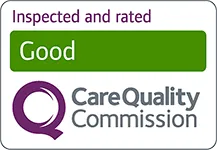Although it is more likely to affect women, lipoedema can impact people of all genders, and can have a significant effect on a person’s day-to-day life.
To learn more about the causes, symptoms, treatments and preventive measures related to lipoedema, keep reading.
How do I know if I have lipoedema?
The main symptom of lipoedema is swollen limbs. The condition can affect either the arms or the legs, but more commonly the latter, and usually affects both sides of the body equally. A person with lipoedema may have swollen legs and buttocks, but a much smaller waist and upper body. Notably, the hands and feet aren’t generally affected by this build-up of fatty tissue.
Other symptoms you may experience include:
- Tenderness or pain in the areas affected by swelling
- A feeling of heaviness in swollen areas
- Bruising easily
- An ‘orange-peel’ texture to the affected skin
Additionally, lipoedema can cause conditions such as:
- Knock knees – where there’s a large gap between your feet when you stand with your knees together
- Flat feet – also known as fallen arches
- Joint-related issues
These problems can all make walking and general mobility difficult. Living with lipoedema can be very tough, and may result in feelings of anxiety and depression.
Learn how to identify the early warning signs of lipoedema by reading our guide on Spotting Lipoedema Early: Signs, Symptoms & When to Seek Help.
Is lipoedema the same as lymphoedema?
Despite having similar names, lipoedema and lymphoedema are two different conditions. While lipoedema is a build-up of fat cells in the arms or legs, lymphoedema is a swelling caused by the lymphatic system’s failure to drain away excess fluid from that area of the body.
If you aren’t sure whether you have lipoedema or lymphoedema, it’s best to consult a trained medical professional. They can examine the swelling and give you a professional medical opinion. You should consult a doctor if your legs feel hard and tight, but you don’t feel pain when you touch the skin. This may be lymphoedema, which should be treated as soon as possible.
Lipoedema doesn’t usually affect the feet. If you have swollen or puffy feet and ankles, this may be due to oedema. This often goes away on its own after a few days. If the symptoms persist for longer than this, speak to a doctor about what may be causing it and possible treatment options.
What causes lipoedema?
Although lipoedema is by no means a rare condition, its cause is as yet unknown. In some cases, it can run in families, which may suggest a genetic predisposition or hereditary trait has some bearing on whether or not you get it. For this reason, doctors believe you may be at a greater risk of developing lipoedema if a close family member has had it.
Another theory is that lipoedema is caused by a change or imbalance of hormones in the body. A person may be more likely to experience lipoedema during:
- Pregnancy
- The menopause or perimenopause
- Use of hormonal contraceptives such as the pill, IUS or injection
- Puberty
One thing that is known about lipoedema is that it isn’t caused by being overweight. Many people who get lipoedema are a healthy weight before, during and after. However, stigma related to this misconception may increase feelings of anxiety and depression associated with lipoedema.
How to get rid of lipoedema
If you think you might have lipoedema, it’s always best to talk to your doctor. They may refer you to a specialist for treatment. As it stands, there is no cure for lipoedema, but there are a range of treatments that may ease the symptoms or prevent the condition from getting worse. The treatment you are advised to try will likely depend on the severity of your particular symptoms and their impact on your life.
The main treatments for lipoedema are liposuction, compression therapy and counselling. Your doctor may also recommend more minor treatments, such as keeping the affected areas moisturised, eating healthily and maintaining a good exercise routine.
Liposuction
As lipoedema is a build-up of fatty tissue, one way of combating the problem is to remove some of that tissue. This can be done in a liposuction or vaser liposuction procedure. Many people prefer this treatment option as it provides quicker results – once the fat is removed the swelling should lessen.
However, depending on the severity of the lipoedema, you may need to have several sessions of liposuction in order to solve the problem. Liposuction may not be available on the NHS, and people often choose to go private to get the operation done. This has the advantage of meaning you can have liposuction as part of a bigger procedure, such as a thigh lift, which aims to tackle loose skin as well as removing fatty tissue.
Compression therapy
Another popular treatment option is compression therapy. This means wearing special compression garments that are designed to fit the shape and size of your limb. Although compression therapy won’t necessarily reduce the swelling of your limbs, it can help to limit the symptoms of lipoedema in three ways:
- Reducing pain and tenderness in affected areas
- Improving mobility (which may help to reduce low self-esteem and depression)
- Supporting limb tissue
In terms of pain management, compression therapy is thought to be particularly effective when combined with exercise. It is believed that both treatments have anti-inflammatory effects which ease the swelling caused by lipoedema.
Counselling
Like compression therapy, counselling is not intended as a treatment for the lipoedema itself, but for some of the symptoms. Cognitive behavioural therapy (CBT) and other forms of counselling may be helpful if your lipoedema causes feelings of anxiety, low self-esteem or depression.
Counselling is intended to make living with lipoedema easier, as your mental health can be affected just as much as your physical health. Trained counsellors may also be able to signpost you to other services which may be helpful to you, including support groups made up of other people experiencing lipoedema.
Can you prevent lipoedema?
Since the cause of lipoedema isn’t known, it is unclear if anything can be done to prevent it. However, if you have a family member who has or has had lipoedema, or if you are worried about developing it yourself, the best course of action is to maintain as healthy a lifestyle as possible. This includes:
- Eating a healthy, balanced diet
- Getting plenty of regular exercise
- Looking after your mental health
While these things may not prevent you from getting lipoedema in the future, they may make it easier for you to manage the condition, and can help to prevent other conditions from developing.
Lipoedema Liposuction Before And After Gallery
Read Our Patient Reviews
Explore our reviews made by real patients
Meet Our Expert Surgeons
Get to know our highly experienced surgeons
Consultation Locations
We offer Consultations from a number of locations around the UK
Prices and finance
We have partnered with Chrysalis Finance, allowing patients to apply for cosmetic surgery finance for all our procedures
Consultation Locations
Manchester Hospital
Manchester Private Hospital New Court, Regents Place, Windsor
Street Salford, Greater Manchester, M5 4HB.




























